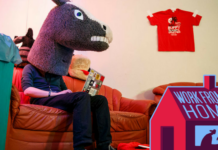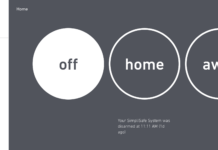The platform was built on the backs of independent creators, but now YouTube is abandoning them for more traditional content
Danny Philippou is mad.
He’s practically standing on top of his chair as his twin brother and fellow YouTube creator Michael stares on in amusement. Logan Paul, perhaps YouTube’s most notorious character, laughs on the other side of the desk that they’re all sitting around for an episode of his popular podcast Impaulsive. Anyone who’s watched the Philippous’ channel, RackaRacka, won’t be surprised by Danny’s antics. This is how he gets when he’s excited or angry. This time, he’s both.
“It’s not fair what they’re doing to us,” Danny yells. “It’s just not fair.”
Danny, like many other creators, is proclaiming the death of YouTube — or, at least, the YouTube that they grew up with. That YouTube seemed to welcome the wonderfully weird, innovative, and earnest, instead of turning them away in favor of late-night show clips and music videos.
The Philippou twins hover between stunt doubles and actors, with a penchant for the macabre. But YouTube, the platform where they built their audience base, doesn’t seem to want them anymore. A search for the popular video in which the brothers used CGI to re-create Mortal Kombat’s most gruesome “fatalities,” resulted in YouTube surfacing mirrored versions, reuploads, and reaction videos. But the original was nowhere to be found. It was hidden by YouTube for violating the company’s guidelines over excessive violence in a video, and the RackaRacka twins think it’s bullshit.
“YouTube calls it a glitch in the system, but what fucking glitch? They tell us that our videos aren’t hidden, but then why aren’t any of our videos surfacing?” Danny says.
The Philippous’ story is part of a long-brewing conflict between how creators view YouTube and how YouTube positions itself to advertisers and press. YouTube relies on creators to differentiate itself from streaming services like Netflix and Hulu, it tells creators it wants to promote their original content, and it hosts conferences dedicated to bettering the creator community. Those same creators often feel abandoned and confused about why their videos are buried in search results, don’t appear on the trending page, or are being quietly demonetized.
At the same time, YouTube’s pitch decks to advertisers increasingly seem to feature videos from household celebrity names, not creative amateurs. And the creators who have found the most success playing into the platform’s algorithms have all demonstrated profound errors in judgment, turning themselves into cultural villains instead of YouTube’s most cherished assets.
As YouTube battles misinformation catastrophes and discovers new ways people are abusing its system, the company is shifting toward more commercial, advertiser-friendly content at a speed its creator community hasn’t seen before.
The golden age of YouTube — the YouTube of a million different creators all making enough money to support themselves by creating videos about doing what they love — is over.
It starts with creators… and piracy
YouTube was founded on the promise of creating a user-generated video platform, but it was something else that helped the site explode in popularity: piracy.
When Google bought YouTube in 2006 for $1.6 billion, the platform had to clean up its massive piracy problems. It was far too easy to watch anything and everything on YouTube, and movie studios, television conglomerates, and record labels were seething. Under Google, YouTube had to change. So YouTube’s executives focused on lifting up the very content its founders designed the platform with in mind: original videos.
The focus on creator culture defined YouTube culture from its earliest days. The platform was a stage for creators who didn’t quite fit into Hollywood’s restrictions. It allowed people like Jenna Marbles; Felix “PewDiePie” Kjellberg; Anthony Padilla, Ian Hecox, and their channel Smosh; and Lilly Singh to thrive. They were each driven to create a form of entertainment that wasn’t happening elsewhere, and their work was incredibly unique: Marbles riffed on stereotypes of women, Kjellberg became notable for his gaming live streams, Smosh did variety sketches, and Singh did impressions of her Indian Canadian family.
Between 2008 and 2011, the volume of videos uploaded to YouTube jumped from 10 hours every minute to 72 hours a minute. By 2011, YouTube had generated more than 1 trillion views; people were watching over 3 billion hours of video every month, and creators were earning real money via Google AdSense — a lot of money. Jenna Marbles was making more than six figures by late 2011. (In 2018, a select group of creators working within YouTube’s top-tier advertising platform would make more than $1 million a month.)
By 2012, creators like Kjellberg were leaving school or their jobs to focus on YouTube full-time. He told a Swedish news outlet that he was getting more than 2 million views a month, boasting just over 300,000 subscribers. It was a level of attention completely new to him. “I almost feel unworthy,” Kjellberg said at the time. “It’s too much. I was happy even just having this as my job. But now, when there are so many people that are watching and appreciate it, it’s really a lot of fun.” He, perhaps more than anyone else on the platform, demonstrated what success on YouTube could look like.
Between 2011 and 2015, YouTube was a haven for comedians, filmmakers, writers, and performers who were able to make the work they wanted and earn money in the process. It gave birth to an entirely new culture that crossed over into the mainstream: Issa Rae’s Awkward Black Girl series would eventually lead to HBO’s Insecure. Creators like the Rooster Teeth team and Tyler Oakley went on tour to meet fans after generating massive followings online. YouTube had reached mainstream success, but in many ways, it still felt wide open. Anyone could still upload almost anything they wanted without much input from YouTube itself.
YouTube’s interests begin to change
Behind the scenes, things were changing. YouTube had begun tinkering with its algorithm to increase engagement and experimenting with ways to bring flashier, produced content to the platform to keep up with growing threats like Netflix.
In October 2012, YouTube announced that its algorithm had shifted to prefer videos with longer watch times over higher view counts. “This should benefit your channel if your videos drive more viewing time across YouTube,” the company wrote in a blog post to creators.
This meant viral videos like “David After Dentist” and “Charlie Bit My Finger,” which defined YouTube in its earliest days, weren’t going to be recommended as much as longer videos that kept people glued to the site. In response, the YouTube community began creating videos that were over 10 minutes in length as a way to try to appease the system.
“I’ve figured out ways to monetize and to take advantage of the power of the algorithm,” comedian Cody Ko told Digiday last year. “Obviously, it preferences longer videos, throwing multiple mid-rolls in, which tons of people do now.”
Then there was original content. In 2011, YouTube invested $100 million into more than 50 “premium” channels from celebrities and news organizations, betting that adding Hollywood talent and authoritative news sources to the platform would drive up advertising revenue and expand YouTube to an even wider audience. It failed less than two years later, with what appeared to be a clear lesson: talent native to YouTube was far more popular than any big names from the outside.
YouTube took that lesson and made YouTube Red. In October 2015, YouTube launched a $9.99-per-month subscription plan that included ad-free viewing and new original series. Unlike YouTube’s last premium initiative, YouTube Red leverage the platform’s homegrown talent — including Singh and Kjellberg — and paired them with professional filmmakers to draw in subscribers. Bringing household celebrity names to YouTube while keeping the faces of the creator community front and center seemed like the best way to make a move into a space dominated by Netflix while staying true to YouTube’s audience.
For a while, the creator community, which was thriving, thanks to sponsorship deals and Google’s ad platform, was satisfied. Prank channels like Fouseytube jumped in popularity; gaming became a massive ecosystem; beauty how-tos took off; vlogging went mainstream; unboxing videos became all the rage; toy channels exploded out of nowhere; family videos found an ardent niche; and although graphic sketch videos like the RackaRacka twins’ may not have been what Google showed off to advertisers, it was easy to find on the platform. 2015 was a year when YouTube was at its most vibrant.
Then, suddenly, creators started encountering problems on the platform. In 2016, personalities like Philip DeFranco, comedians like Jesse Ridgway, and dozens of other popular creators started noticing that their videos were being demonetized, a term popularized by the community to indicate when something had triggered YouTube’s system to remove advertisements from a video, depriving them of revenue. No one was quite sure why, and it prompted complaints about bigger algorithm changes that appeared to be happening.
Kjellberg posted a video detailing how changes had dropped his viewership numbers. He’d been getting 30 percent of his traffic from YouTube’s suggested feed, but after the apparent algorithm update, the number fell to less than 1 percent. Kjellberg jokingly threatened to delete his channel as a result, which was enough to get YouTube to issue a statement denying that anything had changed. (The denial sidestepped questions of the algorithm specifically, and spoke instead to subscriber counts.)
These perceived, secretive changes instilled creators with a distrust of the platform. It also led to questions about their own self-worth and whether the energy they were spending on creating and editing videos — sometimes north of 80 hours a week — was worth it. Anthony Padilla, a co-founder of Smosh and one of the first big creators on YouTube, said in a recent video that the changes began to affect his mental health.
Initially, Padilla said he saw a clear line between how much work he put into a video, and how many views it brought in. “So I associated that more views meant that my effort paid off,” he said. Then the algorithms appeared to change, and view counts went “all over the place” in ways that he couldn’t make sense of. “I could put hundreds of hours of work into something, and the views could be much lower than I was expecting,” Padilla said. “I would start to equate that with my sense of self-worth.”
Padilla wasn’t the only one feeling that way. By the end of 2016, when algorithm changes were creating headaches for some of the platform’s biggest creators, people started announcing they had to take a break from the site they called home. YouTube wasn’t what it was between 2011 and 2016. They didn’t understand it anymore, and trying to keep up with a machine they didn’t recognize and couldn’t rely on was driving people to burn themselves out faster than ever, including creators like Kjellberg.
YouTube was exerting more control over what users saw and what videos would make money. Once again, the community would adapt. But how it adapted was far more problematic than anyone would have guessed.
Everything is canceled
By the beginning of 2017, YouTube was already battling some of its biggest problems in more than a decade. YouTube’s founders didn’t prepare for the onslaught of disturbing and dangerous content that comes from people being able to anonymously share videos without consequence. Add in a moderation team that couldn’t keep up with the 450 hours of video that were being uploaded every minute, and it was a house of cards waiting to fall.
YouTube had come under fire in Europe and the United States for letting extremists publish terrorism recruitment videos to its platform and for letting ads run on those videos. In response, YouTube outlined the steps it was taking to remove extremist content, and it told advertisers it would be careful about where their ads were placed. It highlighted many creators as a safe option.
But neither YouTube nor Google was prepared for what Felix “PewDiePie” Kjellberg — one of YouTube’s wealthiest independently made creators — would do.
In mid-February 2017, The Wall Street Journal discovered an older video from Kjellberg that included him reacting to a sign held up by two kids that said, “Death to all Jews.” The anti-Semitic comment was included in one of his “react” videos about Fiverr, after having pivoted to more of a variety channel instead of focusing just on games.
His video, along with reports of ads appearing on terrorist content, led to advertisers abandoning YouTube. Kjellberg was dropped from Disney’s Maker Studios, he lost his YouTube Red series, Scare PewDiePie, and he was removed from his spot in Google Preferred, the top-tier ad platform for YouTube’s most prominent creators.
“A lot of people loved the video and a lot of people didn’t, and it’s almost like two generations of people arguing if this is okay or not,” Kjellberg said in an 11-minute video about the situation. “I’m sorry for the words that I used, as I know they offended people, and I admit the joke itself went too far.”
The attention Kjellberg brought to YouTube kickstarted the first “adpocalypse,” a term popularized within the creator community that refers to YouTube aggressively demonetizing videos that might be problematic, in an effort to prevent companies from halting their ad spending.
Aggressively demonetizing videos would become YouTube’s go-to move. It would affect everyone, and YouTube’s top talent would use the platform to air their grievances. While people understood why Kjellberg’s channel had come under scrutiny, they weren’t happy about the greater effect it had on the ecosystem. Everyone seemed to be paying for Kjellberg’s mistake.
The Viner invasion
While YouTube grappled with its first adpocalypse, a new generation of stars was flooding the platform. The January 2017 closure of Vine, a platform for looping six-second videos, left a number of creators and influencers without a platform, and many of those stars moved over to YouTube. David Dobrik, Liza Koshy, Lele Pons, Danny Gonzalez, and, of course, Jake and Logan Paul became instant successes on YouTube — even though many of them had started YouTube channels years before their success on Vine.
YouTube’s biggest front-facing stars began following in the footsteps of over-the-top, “bro” prank culture. (Think: Jackass but more extreme and hosted by attractive 20-somethings.) Logan Paul pretended to be shot and killed in front of young fans; Jake Paul rode dirt bikes into pools; David Dobrik’s friends jumped out of moving cars. The antics were dangerous, but they caught people’s attention. The Viners quickly amassed tens of millions of subscribers, and they were touted by YouTube as the new faces of the platform in the company’s annual YouTube Rewind video, which is essentially a highlight reel for advertisers.
Jake and Logan Paul became the biggest stars of this new wave, performing dangerous stunts, putting shocking footage in their vlogs, and selling merchandise to their young audiences. Although they teetered on the edge of what was acceptable and what wasn’t, they never really crossed the line into creating totally reprehensible content.
But other creators saw something in the Paul brothers that left them concerned. Longtime creators like Kjellberg — who was trying to return his channel to normal after dealing with the consequences of his actions — and Ethan Klein called out the Paul brothers for their dangerous and senseless antics.
“This is the state of YouTube, guys,” Klein said of the video in another video. “These people aren’t like, ‘How do I make good content?’ It’s more like, ‘How do I make dangerous, risky shit that’s so over the top that people have to click it?’”
Their complaints propelled the Pauls even further. The brothers hit back with a series of diss tracks that brought in more than 150 million views, making them bonafide YouTube celebrities who are incredibly wealthy.
It didn’t matter that Jake Paul had been evicted for performing YouTube stunts at all hours of the night or that Logan Paul caused a riot at VidCon, a popular YouTube convention, when meeting thousands of his fans. YouTube still promoted them to advertisers and brought them into Google Preferred. Brands like Nike were appearing in Logan Paul videos, even when those videos included children watching a “prank” of their favorite vlogger being shot against a window.
It wasn’t a sustainable form of entertainment, and it seemed like everyone understood that except for YouTube. The Paul brothers were on their way to burning out; all it would take was one grand mistake. Even critics of the Pauls, like Kjellberg, empathized with their position. Kjellberg, who faced controversy after controversy, spoke about feeling as though right or wrong ceased to exist when trying to keep up with the YouTube machine.
“The problem with being a YouTuber or an online entertainer is that you constantly have to outdo yourself,” Kjellberg said in a 2018 video. “I think a lot of people get swept up in that … that they have to keep outdoing themselves, and I think it’s a good reflection of what happened with Logan Paul. If you make videos every single day, it’s really tough to keep people interested and keep them coming back.”
Still, Logan Paul was small potatoes compared to YouTube’s bigger problems, including disturbing children’s content that had been discovered by The New York Times and more terrorism content surfacing on the site. Who cared about what two brothers from Ohio were doing? The breaking point would be when Logan Paul visited Japan.
2018 was the nail in the coffin
Logan Paul’s “suicide forest” video irrevocably changed YouTube.
In it, Paul and his friends tour Japan’s Aokigahara forest, where they encountered a man’s body. Based on the video, it appears that he had recently died by suicide. Instead of turning the camera off, Paul walks up to the body. He doesn’t stop there. He zooms in on the man’s hands and pockets. In post-production, Paul blurred the man’s face, but it’s hard to see the video as anything but an egregious gesture of disrespect.
Within hours of posting the video, Paul’s name began trending. Actors like Aaron Paul (no relation), influencers like Chrissy Teigen, and prominent YouTubers called out Paul for his atrocious behavior.
YouTube reacted with a familiar strategy: it imposed heavy restrictions on its Partner Program (which recognizes creators who can earn ad revenue on their videos), sharply limiting the number of videos that were monetized with ads. In a January 2018 blog post announcing the changes, Robert Kyncl, YouTube’s head of business, said the move would “allow us to significantly improve our ability to identify creators who contribute positively to the community,” adding that “these higher standards will also help us prevent potentially inappropriate videos from monetizing which can hurt revenue for everyone.”
Once again, the effects rippled through the community. Smaller creators like Christine Barger, a lifestyle creator who was in the Partner Program, would be kicked out of YouTube’s monetization program following the new sanctions.
“I feel stupid for crying because. Honestly, it’s silly; it’s not like it’s millions of dollars. It’s not about the money. It’s about the fact that I’ve been a part of YouTube for a really long time, and I’ve finally tried to be a part of this platform, just to feel like they don’t care about small creators,” she said.
The only people who didn’t receive blame were YouTube executives themselves — something that commentators like Philip DeFranco took issue with after the controversy first occurred. “We’re talking about the biggest creator on YouTube posting a video that had over 6 million views, was trending on YouTube, that no doubt had to be flagged by tons of people,” DeFranco said.
“The only reason it was taken down is Logan or his team took it down, and YouTube didn’t do a damn thing. Part of the Logan Paul problem is that YouTube is either complicit or ignorant.”
For small creators, the following months would be even worse. YouTube faced an escalating crisis of radicalization and sweeping conspiracy theories that had been ignored by executives for years.
The company’s first small efforts to address these serious issues — promoting content from musicians, late-night shows, and recommending fewer independent creators — would have huge secondary effects on the middle-tier creators who had once been the heart of the platform during its golden period. It pushed YouTube toward the exact same Hollywood content to which it had once been an alternative.
“So what do you do? What happens next?”
In 2014, YouTube launched a glossy ad campaign in cities like New York, Los Angeles, and Chicago, touting the success of its homegrown, independent artists. Writers, actors, directors, and comedians like Video Game High School’s Freddie Wong and Matt Arnold, baker Rosanna Pansino, and Epic Rap Battles were highlighted.
But by the middle of 2018, lifestyle vloggers like Carrie Crista, who has just under 40,000 subscribers, were proclaiming how the community felt: forgotten. “YouTube seems to have forgotten who made the platform what it is,” Crista told PR Week. In its attempt to compete with Netflix, Hulu, and Amazon, she said, YouTube is “pushing content creators away instead of inviting them to a social platform that encourages them to be creative in a way that other platforms can’t.”
Even people outside of YouTube saw what was happening. “YouTube is inevitably heading towards being like television, but they never told their creators this,” Jamie Cohen, a professor of new media at Molloy College, told USA Today in 2018.
By promoting videos that meet certain criteria, YouTube tips the scales in favor of organizations or creators — big ones, mostly — that can meet those standards. “Editing, creating thumbnails, it takes time,” Juliana Sabo, a creator with fewer than 1,000 subscribers, said in 2018 after the YouTube Partner Program changes. “You’re just prioritizing a very specific type of person — the type of person that has the time and money to churn out that content.”
Individual YouTube creators couldn’t keep up with the pace of YouTube’s algorithm set. But traditional, mainstream outlets could: late-night shows began to dominate YouTube, along with music videos from major labels. The platform now looked the way it had when it started, but with the stamp of Hollywood approval.
YouTube executives like Kyncl aren’t trying to hide it, either. At the company’s 2018 upfront in New York City, a presentation put on for advertisers at Radio City Music Hall, top creators were nowhere to be found. Instead, there was the YouTube the company wants advertisers to see: Ariana Grande on Vevo, series from Kevin Hart and Demi Lovato, clips from The Tonight Show Starring Jimmy Fallon.
“A year and a half ago, it was all fine,” Danny Philippou says on Logan Paul’s Impaulsive podcast. “We could do whatever we wanted. We could upload whatever we wanted, but every video lately has been getting demonetized and it’s screwed us up. Don’t get us wrong; we still put in 200 percent effort into every video we make, but creatively and financially we’ve been at a bit of a standstill.”
The RackaRacka brothers are tired.
“We loved it before when it was like, ‘Oh, you guys are doing something unique and different. Let’s help you guys so you can get views and get eyes on it,’” Danny says. “I’d love to go back to that. We have so many big, awesome ideas that we’d love to do, but there’s no point in doing it on YouTube.”
In the process of writing this story, YouTube representatives called multiple times to inquire about the piece and request more time in order to respond. Ultimately, the company declined to comment, including on why RackaRacka’s Mortal Kombat video wasn’t appearing in search. As of this week, the video has started to show up again.
There’s a moment in the podcast, toward the end, when Logan looks at the Philippou brothers and asks them, “So what do you do? What happens next?” They laugh, and then Michael answers without hesitation, with the expediency of someone who’s thought of this for some time.
“We leave. We find somewhere else that wants our videos. That used to be YouTube, but it’s not anymore. And I don’t think it ever will be again.”






























![[Update: Fixed] Google Nest outage takes down Thermostat, Cam live video, and apps](http://cdn.smarthometimes.com/wp-content/uploads/2020/04/nest_thermostat_1-218x150.jpg)








